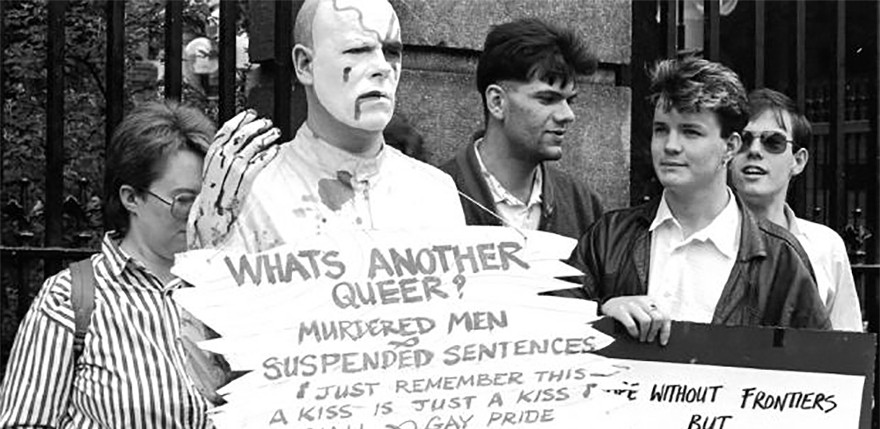
Thom 'The Diceman' McGinty: street performer and Dublin legend
27 February 2020It is twenty-five years since the death of Thom McGinty: street performer and gay activist and icon, known to Dubliners as 'The Diceman'.
By Lawrence William White
Thom McGinty (‘The Diceman’) (1952–95), street performer, was born in Strathclyde, Scotland, one of two sons and two daughters of Thomas McGinty and Mary McGinty (maiden name unknown), a native of Co. Dublin. After training in Glasgow in theatre and as an artists’ model, he moved to Dublin in 1976, supporting himself with modelling work in the National College of Art and Design. Lacking singing or musical talents, he conceived a unique form of busking by donning makeup and costume, and standing mute and motionless in the Dandelion Market, off St Stephen's Green, as a character he called the Dandelion Clown, ‘a colourful pseudo-beggar’ (his own phrase, repeated in most obituaries); when thrown money by passers-by, he often thanked them with a coy and rapid wink of an eye. On the market's closure, he worked in a touring theatre troupe, ran workshops, and attempted unsuccessfully to launch a full-time theatre company in Spiddal, Co. Galway. In the early 1980s he revived his human-statue act as an advertisement for a Grafton St. games shop called The Diceman. Standing absolutely stationary in an eerily spectral costume for hours at a stretch on Dublin's premier shopping street, he became in this conspicuous location a familiar figure of the city's street life, and its most renowned street artist, known to the public by the same name as the shop; the name persisted through numerous subsequent character reincarnations. Baffling many first-time onlookers uncertain whether or not he was animate, he might startle the unwary with a sudden movement: a gesture, a grimace, or the seductive, conspiratorial eyewink. As sizeable crowds gathered round him, frequently impeding traffic on the street and pavement, he developed a slow, nearly imperceptible walk, thereby avoiding arrest for loitering.
Initially contracted for a three-week period, he advertised for the Diceman shop for three years until its closure. Thereafter he advertised for many other businesses, products, and ventures, creating hundreds of inventive visuals, typically laced with irony and humour; for Bewley's cafés alone he appeared as a Halloween Brack-ula, a green Santa Claus, and a composite Easter-egg chicken. Prosecuted for indecency for promoting a stage production of the ‘Rocky horror picture show’ as The Vamp, wearing only G-string, fishnet stockings, and a flowing feather boa (which got caught in the door of the garda van during his arrest), he received a probationary sentence (1991). He performed in festivals and parades throughout Ireland, and in Berlin, Paris, Moscow, and Seville. Appearing in character at many political protests, especially regarding human rights and AIDS-related issues, he was one of the first artists in Ireland to assist in fundraising efforts for AIDS awareness organisations and charities, and on behalf of the gay rights movement. At the first Gay Pride celebrations pursuant to the decriminalisation of homosexual acts (for which he had demonstrated outside Leinster House), he appeared memorably as a Prisoner Breaking Free (1993).
Testing positive for HIV in December 1990, he continued to work until forced by declining health to retire from street performing in 1994. Launching an entertainment company, Living Visuals, to continue the various characters of his invention, he continued to appear at selected benefits and performances. One of the first public figures in Ireland to announce himself as being HIV-positive, he spoke movingly and candidly about his illness on RTÉ's ‘Late, late show’ (November 1994), desirous to be perceived as a person living with, rather than dying from, AIDS, and thereafter received numerous expressions of support. Resident in his last days on Norfolk Road, Phibsborough, he died 20 February 1995 in Dublin. After a funeral procession down Grafton St., where 2,000 onlookers fittingly stood still and silent, his remains were cremated at Glasnevin cemetery, and the ashes scattered at Baltinglass, Co. Wicklow, where he believed himself to have been conceived. An enthusiastic, expansive personality, who revelled in music, travel, and camaraderie, McGinty, with his unique skills in mime, introduced a high level of theatricality, wit, and technique into street performance in Dublin, spawning a legion of imitators, but few so gifted as to be emulators.
Sources: Ir. Times, 21–4 Feb. 1995; Sunday Tribune, 26 Feb. 1995; Daily Telegraph, 2 Mar. 1995; Gay Community News (Mar. 1995); Pete Short, ‘King of the streets’, Hot Press, xix, no. 5 (23 Mar. 1995), 13
The Dictionary now comprises over 10,600 lives.
Follow the DIB on Twitter @DIB_RIA – where we post topical biographies.
All biographies are available at: dib.cambridge.org
© 2019 Royal Irish Academy. All rights reserved. Not for commercial use or unauthorized distribution. Learn more about DIB copyright and permissions.
The Little Museum of Dublin is celebrating the life and work of Thom McGinty with an exhibition running until 21 May 2020.



